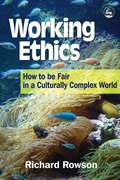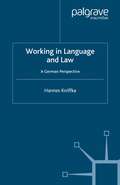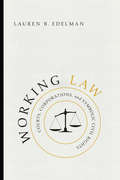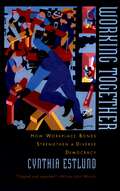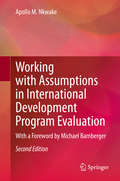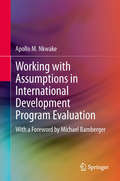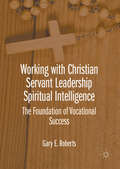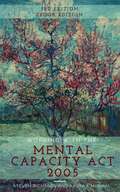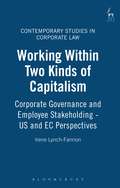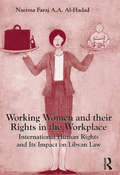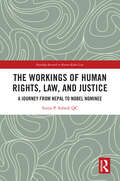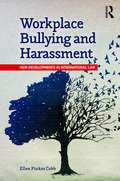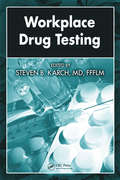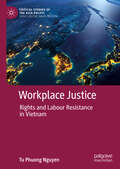- Table View
- List View
Working Ethics: How to Be Fair in a Culturally Complex World (PDF)
by Richard RowsonWorking Ethics sets out an ethical foundation for professionals and for the professions in a modern, culturally complex society. This book will be of interest to anyone who takes seriously their obligations to society as a whole and to the individuals with whom they work. Richard Rowson puts forward an ethical framework comprising four basic elements - fairness, respect for autonomy, integrity, and seeking the most beneficial and least harmful consequences. The three parts of the book explore: * sources of ethical guidance such as laws, social conventions, professional codes of conduct and religious beliefs, identifying the ethical values integral to the professions * the obligations these values give to members of the professions, and the ethical issues which arise when they are concerned to produce benefits and prevent harm, treat people fairly, respect others and act with integrity * how these values might be incorporated into professional practice. The book ends with a brief guide to dealing with blame in a professional context and claims about rights. At the end of each chapter, key questions encourage readers to think through the issues discussed. Rowson shows how this ethical framework can enable professionals to work more effectively, earn trust, mutual support and respect, and how it can foster democratic ideals in the workplace and community. This book will be essential reading for professionals in the public and private sector - including teachers, civil servants, police personnel, nurses, doctors, lawyers, accountants and engineers.
Working in Language and Law: A German Perspective
by H. KniffkaWorking in Language and Law is a detailed account of the forensic linguistic work done by the author in the last 35 years. It provides exemplary insights into an ever-expanding field of expert testimony, focusing on the situation in Germany since the seventies and covering all major areas of the field.
Working It Out
by Alex GeorgeWatch out Bridget Jones and Ally McBeal – Johnathan Burlip wants you to know his side of the story!
Working Law: Courts, Corporations, and Symbolic Civil Rights (Chicago Series in Law and Society)
by Lauren B. EdelmanSince the passage of the Civil Rights Act, virtually all companies have antidiscrimination policies in place. Although these policies represent some progress, women and minorities remain underrepresented within the workplace as a whole and even more so when you look at high-level positions. They also tend to be less well paid. How is it that discrimination remains so prevalent in the American workplace despite the widespread adoption of policies designed to prevent it? One reason for the limited success of antidiscrimination policies, argues Lauren B. Edelman, is that the law regulating companies is broad and ambiguous, and managers therefore play a critical role in shaping what it means in daily practice. Often, what results are policies and procedures that are largely symbolic and fail to dispel long-standing patterns of discrimination. Even more troubling, these meanings of the law that evolve within companies tend to eventually make their way back into the legal domain, inconspicuously influencing lawyers for both plaintiffs and defendants and even judges. When courts look to the presence of antidiscrimination policies and personnel manuals to infer fair practices and to the presence of diversity training programs without examining whether these policies are effective in combating discrimination and achieving racial and gender diversity, they wind up condoning practices that deviate considerably from the legal ideals.
Working Law: Courts, Corporations, and Symbolic Civil Rights (Chicago Series in Law and Society)
by Lauren B. EdelmanSince the passage of the Civil Rights Act, virtually all companies have antidiscrimination policies in place. Although these policies represent some progress, women and minorities remain underrepresented within the workplace as a whole and even more so when you look at high-level positions. They also tend to be less well paid. How is it that discrimination remains so prevalent in the American workplace despite the widespread adoption of policies designed to prevent it? One reason for the limited success of antidiscrimination policies, argues Lauren B. Edelman, is that the law regulating companies is broad and ambiguous, and managers therefore play a critical role in shaping what it means in daily practice. Often, what results are policies and procedures that are largely symbolic and fail to dispel long-standing patterns of discrimination. Even more troubling, these meanings of the law that evolve within companies tend to eventually make their way back into the legal domain, inconspicuously influencing lawyers for both plaintiffs and defendants and even judges. When courts look to the presence of antidiscrimination policies and personnel manuals to infer fair practices and to the presence of diversity training programs without examining whether these policies are effective in combating discrimination and achieving racial and gender diversity, they wind up condoning practices that deviate considerably from the legal ideals.
Working Law: Courts, Corporations, and Symbolic Civil Rights (Chicago Series in Law and Society)
by Lauren B. EdelmanSince the passage of the Civil Rights Act, virtually all companies have antidiscrimination policies in place. Although these policies represent some progress, women and minorities remain underrepresented within the workplace as a whole and even more so when you look at high-level positions. They also tend to be less well paid. How is it that discrimination remains so prevalent in the American workplace despite the widespread adoption of policies designed to prevent it? One reason for the limited success of antidiscrimination policies, argues Lauren B. Edelman, is that the law regulating companies is broad and ambiguous, and managers therefore play a critical role in shaping what it means in daily practice. Often, what results are policies and procedures that are largely symbolic and fail to dispel long-standing patterns of discrimination. Even more troubling, these meanings of the law that evolve within companies tend to eventually make their way back into the legal domain, inconspicuously influencing lawyers for both plaintiffs and defendants and even judges. When courts look to the presence of antidiscrimination policies and personnel manuals to infer fair practices and to the presence of diversity training programs without examining whether these policies are effective in combating discrimination and achieving racial and gender diversity, they wind up condoning practices that deviate considerably from the legal ideals.
Working Law: Courts, Corporations, and Symbolic Civil Rights (Chicago Series in Law and Society)
by Lauren B. EdelmanSince the passage of the Civil Rights Act, virtually all companies have antidiscrimination policies in place. Although these policies represent some progress, women and minorities remain underrepresented within the workplace as a whole and even more so when you look at high-level positions. They also tend to be less well paid. How is it that discrimination remains so prevalent in the American workplace despite the widespread adoption of policies designed to prevent it? One reason for the limited success of antidiscrimination policies, argues Lauren B. Edelman, is that the law regulating companies is broad and ambiguous, and managers therefore play a critical role in shaping what it means in daily practice. Often, what results are policies and procedures that are largely symbolic and fail to dispel long-standing patterns of discrimination. Even more troubling, these meanings of the law that evolve within companies tend to eventually make their way back into the legal domain, inconspicuously influencing lawyers for both plaintiffs and defendants and even judges. When courts look to the presence of antidiscrimination policies and personnel manuals to infer fair practices and to the presence of diversity training programs without examining whether these policies are effective in combating discrimination and achieving racial and gender diversity, they wind up condoning practices that deviate considerably from the legal ideals.
Working Law: Courts, Corporations, and Symbolic Civil Rights (Chicago Series in Law and Society)
by Lauren B. EdelmanSince the passage of the Civil Rights Act, virtually all companies have antidiscrimination policies in place. Although these policies represent some progress, women and minorities remain underrepresented within the workplace as a whole and even more so when you look at high-level positions. They also tend to be less well paid. How is it that discrimination remains so prevalent in the American workplace despite the widespread adoption of policies designed to prevent it? One reason for the limited success of antidiscrimination policies, argues Lauren B. Edelman, is that the law regulating companies is broad and ambiguous, and managers therefore play a critical role in shaping what it means in daily practice. Often, what results are policies and procedures that are largely symbolic and fail to dispel long-standing patterns of discrimination. Even more troubling, these meanings of the law that evolve within companies tend to eventually make their way back into the legal domain, inconspicuously influencing lawyers for both plaintiffs and defendants and even judges. When courts look to the presence of antidiscrimination policies and personnel manuals to infer fair practices and to the presence of diversity training programs without examining whether these policies are effective in combating discrimination and achieving racial and gender diversity, they wind up condoning practices that deviate considerably from the legal ideals.
Working Law: Courts, Corporations, and Symbolic Civil Rights (Chicago Series in Law and Society)
by Lauren B. EdelmanSince the passage of the Civil Rights Act, virtually all companies have antidiscrimination policies in place. Although these policies represent some progress, women and minorities remain underrepresented within the workplace as a whole and even more so when you look at high-level positions. They also tend to be less well paid. How is it that discrimination remains so prevalent in the American workplace despite the widespread adoption of policies designed to prevent it? One reason for the limited success of antidiscrimination policies, argues Lauren B. Edelman, is that the law regulating companies is broad and ambiguous, and managers therefore play a critical role in shaping what it means in daily practice. Often, what results are policies and procedures that are largely symbolic and fail to dispel long-standing patterns of discrimination. Even more troubling, these meanings of the law that evolve within companies tend to eventually make their way back into the legal domain, inconspicuously influencing lawyers for both plaintiffs and defendants and even judges. When courts look to the presence of antidiscrimination policies and personnel manuals to infer fair practices and to the presence of diversity training programs without examining whether these policies are effective in combating discrimination and achieving racial and gender diversity, they wind up condoning practices that deviate considerably from the legal ideals.
The Working of the Indian Constitution
by Arghya Sengupta and Omita GoyalThe Indian Constitution has held the country together for 75 years now. This volume demonstrates the Constitution is not a static document and has seen several amendments and interpretations over the years. It delves into how the document has worked for the people since its adoption — its strengths and weaknesses, its many interpretations, how it has influenced and shaped our collectives over time and in turn been shaped by the people.The Indian Constitution clearly vests power in the hands of its people. This volume critically examines how the longest written national Constitution is made successful by people who take its spirit to heart and let it inform their activities, and how like anywhere in the world, it is a work in progress. It covers a range of debates on issues such as individual freedom (of expression, of association, freedom to lead lives of dignity, etc.), liberty (freedom from oppression), the right to life, right to equality, justice, among several others. The book contains essays by judges, lawyers and academics who describe the journey of the Constitution through doctrine, case-law, and comparative analyses with other countries. At the same time, it also contains essays by doctors, politicians, activists, bureaucrats, and a number of methodologically diverse essays by a host of demographically diverse writers.The volume will be an indispensable read for scholars and researchers of legal studies, political scientists, governance, public policy, modern history, and South Asia studies. It will also be of immense interest to political scientists, political theorists, legal scholars, historians, lawyers, and general readers interested in the history of the Indian Constitution.
The Working of the Indian Constitution
The Indian Constitution has held the country together for 75 years now. This volume demonstrates the Constitution is not a static document and has seen several amendments and interpretations over the years. It delves into how the document has worked for the people since its adoption — its strengths and weaknesses, its many interpretations, how it has influenced and shaped our collectives over time and in turn been shaped by the people.The Indian Constitution clearly vests power in the hands of its people. This volume critically examines how the longest written national Constitution is made successful by people who take its spirit to heart and let it inform their activities, and how like anywhere in the world, it is a work in progress. It covers a range of debates on issues such as individual freedom (of expression, of association, freedom to lead lives of dignity, etc.), liberty (freedom from oppression), the right to life, right to equality, justice, among several others. The book contains essays by judges, lawyers and academics who describe the journey of the Constitution through doctrine, case-law, and comparative analyses with other countries. At the same time, it also contains essays by doctors, politicians, activists, bureaucrats, and a number of methodologically diverse essays by a host of demographically diverse writers.The volume will be an indispensable read for scholars and researchers of legal studies, political scientists, governance, public policy, modern history, and South Asia studies. It will also be of immense interest to political scientists, political theorists, legal scholars, historians, lawyers, and general readers interested in the history of the Indian Constitution.
Working Together: How Workplace Bonds Strengthen a Diverse Democracy
by Cynthia EstlundThe typical workplace is a hotbed of human relationships--of friendships, conflicts, feuds, alliances, partnerships, coexistence and cooperation. Here, problems are solved, progress is made, and rifts are mended because they need to be - because the work has to get done. And it has to get done among increasingly diverse groups of co-workers. At a time when communal ties in American society are increasingly frayed and segregation persists, the workplace is more than ever the site where Americans from different ethnic, religious, and racial backgrounds meet and forge serviceable and sometimes lasting bonds. What do these highly structured workplace relationships mean for a society still divided by gender and race? Structure and rules are, in fact, central to the answer. Workplace interactions are constrained by economic power and necessity, and often by legal regulation. They exist far from the civic ideal of free and equal citizens voluntarily associating for shared ends. Yet it is the very involuntariness of these interactions that helps to make the often-troubled project of racial integration comparatively successful at work. People can be forced to get along-not without friction, but often with surprising success. This highly original exploration of the paradoxical nature--and the paramount importance--of workplace bonds concludes with concrete suggestions for how law can further realize the democratic possibilities of working together. In linking workplace integration and connectedness beyond work, Estlund suggests a novel and promising strategy for addressing the most profound challenges facing American society.
Working with Assumptions in International Development Program Evaluation: With a Foreword by Michael Bamberger
by Apollo M. NkwakeThis book discusses the crucial place that assumptions hold in conceptualizing, implementing, and evaluating development programs. It suggests simple ways for stakeholders and evaluators to 1) examine their assumptions about program theory and environmental conditions and 2) develop and carry out effective program monitoring and evaluation in light of those assumptions. A survey of evaluators from an international development agency reviewed the state of practice on assumptions-aware evaluation. This 2nd edition has been updated with further illustrations, case studies, and frameworks that have been researched and tested in the years since the first edition.Regardless of geography or goal, development programs and policies are fueled by a complex network of implicit ideas. Stakeholders may hold assumptions about purposes, outcomes, methodology, and the value of project evaluation and evaluators—which may or may not be shared by the evaluators. A major barrier to viable program evaluations is that development programs are based on assumptions that often are not well articulated. In designing programs, stakeholders often lack clear outlines for how implemented interventions will bring desired changes. This lack of clarity masks critical risks to program success and makes it challenging to evaluate such programs. Methods that have attempted to address this dilemma have been popularized as theory of change or other theory‐based approaches. Often, however, theory-based methods do not sufficiently clarify how program managers or evaluators should work with the assumptions inherent in the connections between the steps. The critical examination of assumptions in evaluation is essential for effective evaluations and evaluative thinking. "How does one think evaluatively? It all begins with assumptions. Systematically articulating, examining, and testing assumptions is the foundation of evaluative thinking… This book, more than any other, explains how to build a strong foundation for effective interventions and useful evaluation by rigorously working with assumptions." —Michael Quinn Patton, PhD. Author of Utilization-Focused Evaluation and co-editor of THOUGHTWORK: Thinking, Action, and the Fate of the World, USA. "This updated edition presents us with a new opportunity to delve into both the theoretical and practical aspects of paradigmatic, prescriptive, and causal assumptions. We need to learn, and apply these insights with the deep attention they deserve." —Zenda Ofir, PhD. Independent Evaluator, Richard von Weizsäcker Fellow, Robert Bosch Academy, Berlin, Germany. Honorary Professor, School of Public Leadership, Stellenbosch University, South Africa. “This thought-provoking book explains why assumptions are an essential condition within the theories and methodologies of evaluation; and how assumptions influence the ways that evaluators approach their work…It will enrich the ways that evaluators develop their models, devise their methodologies, interpret their data, and interact with their stakeholders.”—Jonny Morell, Ph.D., President, 4.669… Evaluation and Planning, Editor Emeritus, Evaluation and Program Planning
Working with Assumptions in International Development Program Evaluation: With a Foreword by Michael Bamberger
by Apollo M. Nkwake A major reason complex programs are so difficult to evaluate is that the assumptions that inspire them are poorly articulated. Stakeholders of such programs are often unclear about how the change process will unfold. Thus, it is so difficult to reasonably anticipate the early and midterm changes that need to happen in order for a longer-term goalto be reached. The lack of clarity about the “mini-steps” that must be taken to reach a long-term outcome not only makes the task of evaluating a complex initiative challenging, but reduces the likelihood that all of the important factors related to the long term goal will be addressed. Most of the resources that have attempted to address this dilemma have been popularized as theory of change or sometimes program theory approaches. Although these approaches emphasize and elaborate the sequence of changes/mini steps that lead to the long-term goal of interest and the connections between program activities and outcomes that occur at each step of the way, they do not do enough to clarify how program managers or evaluators should deal with assumptions. Assumptions, the glue that holds all the pieces together, remain abstract and far from applicable. In this book the author tackles this important assumptions theme head-on-covering a breadth of ground from the epistemology of development assumptions, to the art of making logical assumptions as well as recognizing, explicit zing and testing assumptions with in an elaborate program theory from program design, implementation, monitoring and evaluation.
Working with Christian Servant Leadership Spiritual Intelligence: The Foundation of Vocational Success
by Gary E. RobertsThis book addresses how Christian leaders integrate faith into the workplace, through a love-based altruistic system of Christian Servant Leadership Spiritual Intelligence (CSLSI). It hypothesizes how CSLSI positively influences a range of desirable employee attitudes and behaviors including servant leadership and followership, organizational citizenship, and positive stress coping and adaptation strategies. This book embraces an interdisciplinary approach to present the global attributes of CSLSI, which includes following God’s will and Golden Rule workplace love expression, with specific workplace applications. The empirical research is supplemented by approximately 100 interviews with Christian leaders providing workplace exemplars and a compelling overview of how Christians honor God in the marketplace. This book will appeal to academics and practitioners in business, psychology, medicine, management, leadership, and theology looking to develop a God-honoring work life. Readers will benefit from the principles and the self-diagnostic surveys that assess spiritual intelligence and ways to enhance it.
Working with the Mental Capacity Act (3rd edition)
by Steven Richards Aasya F MughalFrom the authors of the Deprivation of Liberty Safeguards Handbook, Steven Richards and Aasya F Mughal, comes a new edition of the best selling book Working with the Mental Capacity Act 2005. Published in May 2018, it provides a comprehensive and practical guide to the Act for health and social care professionals in all settings. There are detailed chapters on key parts of the Act including: The principles, mental capacity assessments, best interests decisions, restraint, Deprivation of Liberty Safeguards (DoLS), advocacy (IMCA), Court of Protection, lasting powers of attorney (LPA), deputies and advance decisions to refuse treatment (ADRT). Each chapter contains references and quotes from the most recent and relevant case law and the codes of practice to the Act. The book has special dedicated chapters on: • Consent to care and treatment and the link to the Act • Safeguarding adults and the Act • The Mental Health Act and Mental Capacity Act interface • The use of the Act by different care providers including the police, ambulance staff, dentists, GPs, prison healthcare and CCGs Detailed information and case law guidance on specific decisions including: • Admission for care • Contact with other people • Contraception • Marriage • Sexual relations • Tenancy agreements • Testamentary capacity (wills) • Do not attempt cardiopulmonary resuscitation (DNACPR) • End of life decisions Diagrams and charts A series of summary tables, charts and diagrams throughout the book are designed to provide at a glance information and explanations. In addition, every chapter addresses frequently asked practice-based questions asked by health and social care staff.
Working Within Two Kinds of Capitalism: Corporate Governance and Employee Stakeholding - US and EC Perspectives (Contemporary Studies in Corporate Law)
by Irene Lynch-FannonThis text compares the corporate governance structures of the US quoted company and its European equivalent and the role which employees as non-shareholding stakeholders hold within those structures. It focuses on the incidents of ownership normally exercised by stakeholders and raises questions regarding different responses to the issue of mandated labour market regulation on both sides of the Atlantic. The text considers theoretical and practical issues raised in this context.
Working Women and their Rights in the Workplace: International Human Rights and Its Impact on Libyan Law
by Naeima Faraj Al-HadadThis book addresses women’s rights to work and motherhood in Libya from a legal and international human rights perspective. In an attempt to solve the problem posed by the perception that there is an unsolvable conflict between the right of women to work and their right to motherhood, the author considers how these two sets of rights, as protected under international human rights law, can and should be recognised and promoted within the Libyan legal system. Including first-hand accounts of experiences of Libyan women, the study voices their struggle for their rights as guaranteed by domestic law, international conventions and Islam. Providing a rare insight into a region striving to find its new identity, the author assesses the adequacy of existing Libyan laws and, where warranted, offers proposals for legislative amendments to Libyan policy makers and its new Parliament at such a crucial time in the nation’s history.
Working Women and their Rights in the Workplace: International Human Rights and Its Impact on Libyan Law
by Naeima Faraj Al-HadadThis book addresses women’s rights to work and motherhood in Libya from a legal and international human rights perspective. In an attempt to solve the problem posed by the perception that there is an unsolvable conflict between the right of women to work and their right to motherhood, the author considers how these two sets of rights, as protected under international human rights law, can and should be recognised and promoted within the Libyan legal system. Including first-hand accounts of experiences of Libyan women, the study voices their struggle for their rights as guaranteed by domestic law, international conventions and Islam. Providing a rare insight into a region striving to find its new identity, the author assesses the adequacy of existing Libyan laws and, where warranted, offers proposals for legislative amendments to Libyan policy makers and its new Parliament at such a crucial time in the nation’s history.
The Workings of Human Rights, Law and Justice: A Journey from Nepal to Nobel Nominee (Routledge Research in Human Rights Law)
by Surya P. Subedi, QCDrawing on the personal experience of a leading international jurist, this book provides insights into the workings of international law and human rights from a global perspective that transcends the traditional divide between the West and the East, and the Global South and Global North. The work follows the author’s remarkable journey from a simple village in Nepal to becoming an international jurist acclaimed for his innovative academic and influential practical legal work and nomination for the Nobel Peace Prize. It offers insights into the powers bearing on international policymaking, the dynamics of human rights negotiations with governments, and the effects of their outcomes on the lives of their citizens. While much has been written on international human rights law, this inspirational memoir casts a new light on the working of human rights, law, and justice through the eyes of a leading actor. It provides a valuable contribution to the study of justice and human rights and the importance of individual action. As such, the book presents an accessible source for current debates around the development and effectiveness of international law and human rights and practices for decolonising these debates. The book will provide inspiration and practical guidance for students, academics, international lawyers, jurists, and human rights advocates.
The Workings of Human Rights, Law and Justice: A Journey from Nepal to Nobel Nominee (Routledge Research in Human Rights Law)
by Surya P. Subedi, QCDrawing on the personal experience of a leading international jurist, this book provides insights into the workings of international law and human rights from a global perspective that transcends the traditional divide between the West and the East, and the Global South and Global North. The work follows the author’s remarkable journey from a simple village in Nepal to becoming an international jurist acclaimed for his innovative academic and influential practical legal work and nomination for the Nobel Peace Prize. It offers insights into the powers bearing on international policymaking, the dynamics of human rights negotiations with governments, and the effects of their outcomes on the lives of their citizens. While much has been written on international human rights law, this inspirational memoir casts a new light on the working of human rights, law, and justice through the eyes of a leading actor. It provides a valuable contribution to the study of justice and human rights and the importance of individual action. As such, the book presents an accessible source for current debates around the development and effectiveness of international law and human rights and practices for decolonising these debates. The book will provide inspiration and practical guidance for students, academics, international lawyers, jurists, and human rights advocates.
Workplace Bullying and Harassment: New Developments in International Law
by Ellen Pinkos CobbWorkplace Bullying and Harassment: New Developments in International Law provides a comprehensive tour around the globe, summarizing relevant legislation and key developments in workplace bullying, harassment, sexual harassment, discrimination, violence, and stress in over 50 countries in Europe, the Asia Pacific region, the Americas region, and the Middle East and Africa. Workplace bullying, harassment, and other psychological workplace hazards are becoming increasingly acknowledged and legislated against in the modern work world. The costs of bullying, harassment, violence, discrimination, and stress at work are huge and far-reaching. Frequently under-reported and misunderstood, workplace bullying, harassment, violence, discrimination, and stress wreak havoc on the vitality and prosperity of organizations and individuals alike. Workplace laws have long dealt with physical risks, and psychological risks have begun to be treated similarly. In response to the changing workplace, many countries are regulating workplace bullying and harassment by introducing new legislation or incorporating new provisions into existing legislation to address these risks. Other countries have opted for non-regulatory instruments. Numerous European countries, Canada, Australia, and Japan all prohibit and punish workplace bullying and harassment, with other countries, including the United States of America, moving toward legislation against this abusive workplace conduct. This book brings together need-to-know information on global workplace bullying and harassment in one place, the first publication of its kind to do so. It will aid those in the fields of labor and employment, human resources management, occupational and industrial health psychology, health and safety, and workplace regulatory compliance stay abreast of laws and developments that these practitioners must be aware of, whether operating nationally or globally. Academics will also benefit. Links to laws and references are provided, enabling further research.
Workplace Bullying and Harassment: New Developments in International Law
by Ellen Pinkos CobbWorkplace Bullying and Harassment: New Developments in International Law provides a comprehensive tour around the globe, summarizing relevant legislation and key developments in workplace bullying, harassment, sexual harassment, discrimination, violence, and stress in over 50 countries in Europe, the Asia Pacific region, the Americas region, and the Middle East and Africa. Workplace bullying, harassment, and other psychological workplace hazards are becoming increasingly acknowledged and legislated against in the modern work world. The costs of bullying, harassment, violence, discrimination, and stress at work are huge and far-reaching. Frequently under-reported and misunderstood, workplace bullying, harassment, violence, discrimination, and stress wreak havoc on the vitality and prosperity of organizations and individuals alike. Workplace laws have long dealt with physical risks, and psychological risks have begun to be treated similarly. In response to the changing workplace, many countries are regulating workplace bullying and harassment by introducing new legislation or incorporating new provisions into existing legislation to address these risks. Other countries have opted for non-regulatory instruments. Numerous European countries, Canada, Australia, and Japan all prohibit and punish workplace bullying and harassment, with other countries, including the United States of America, moving toward legislation against this abusive workplace conduct. This book brings together need-to-know information on global workplace bullying and harassment in one place, the first publication of its kind to do so. It will aid those in the fields of labor and employment, human resources management, occupational and industrial health psychology, health and safety, and workplace regulatory compliance stay abreast of laws and developments that these practitioners must be aware of, whether operating nationally or globally. Academics will also benefit. Links to laws and references are provided, enabling further research.
Workplace Drug Testing
by Steven B. Karch FfflmExtracted from the Drug Abuse Handbook, 2nd edition, to give you just the information you need at an affordable price. Using sample protocols from the transportation and nuclear power industries, Workplace Drug Testing reviews current federal regulations and mandatory guidelines for federal workplace testing programs and
Workplace Justice: Rights and Labour Resistance in Vietnam (Critical Studies of the Asia-Pacific)
by Tu Phuong NguyenThis book develops an understanding of workplace justice and labour rights in Vietnam from factory workers’ voices and their resistance against abuse and exploitation. Through interviews with workers and a close analysis of their letters and petitions to the unions and state authorities, Nguyen illuminates how workers’ resistance is enabled and stifled by the legal and political systems that are supposed to protect their rights and benefits. Their calls for justice reflect socialist ideology and widely held norms within society, as well as ideals and values embedded in labour law. The book demonstrates how state law brings about social change through shaping workers’ expectations and increasing consciousness of rights and justice. This book will be of interest to scholars of law, politics and society, and scholars, students and practitioners interested in labour rights in developing countries.
